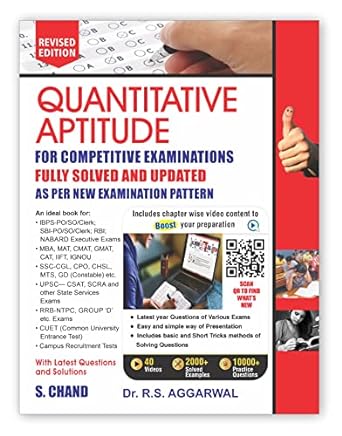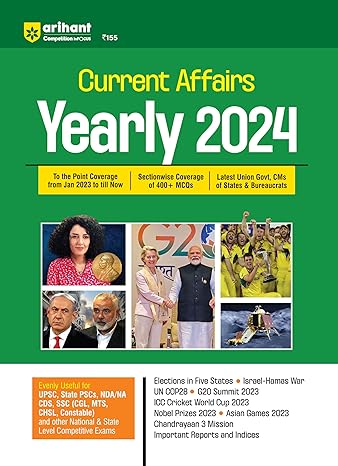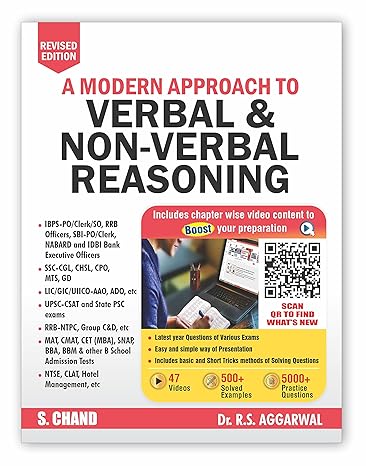CMAT 2026 Study Material – Free PDF Download
FREE CMAT STUDY MATERIAL
Here comes some free CMAT study material that can definitely help in preparation. The material also consists of a free PDF on Current Affairs and Static GK. There are 100 questions in the CMAT exam, each carries 4 marks for the correct answer. There is a negative marking for an incorrect answer and the penalty is -1 mark per incorrect answer.

CMAT QUANT/DI
Boss mode: Quantitative Ability
CMAT LOGICAL REASONING
CMAT LANGUAGE COMPREHENSION
| Reading Comprehension/Verbal Ability Topics |
|---|
| RC Passages |
| Cloze Test |
| Sentence Correction |
| Parajumble |
| Synonym Antonym |
| Idioms Phrases |
| Word Substitution |
| Error Spotting |
| Sentence Improvement |
Boss Mode: Verbal Ability & Reading Comprehension
You can read newspapers on daily basis to score marks in the CMAT GK section. News apps like Daily Hunt, Inshorts, etc. are alternatives to a newspaper.
CMAT Current Affairs Questions July 2025
CMAT PAST PAPERS PDF
In order to improve score in CMAT mocks, one should know the questions asked in the previous exam.
Click here to explore CMAT Previous Years Question Papers.
BOOKS FOR CMAT 2024 PREPARATION
|
|
 |
 |
The CMAT exam is the easiest of all the management entrance exams so most of the students will fetch a good score. The R.S. Aggarwal books are more than enough to prepare coupled with hands-on practice of test series.
CMAT Innovation and Entrepreneurship Notes
- Introduction to Innovation and Entrepreneurship:
- Definition of innovation and entrepreneurship.
- The relationship between innovation and entrepreneurship.
- Importance of innovation and entrepreneurship in driving economic growth.
- Characteristics of Successful Entrepreneurs:
- Passion and motivation.
- Risk-taking and resilience.
- Vision and creativity.
- Flexibility and adaptability.
- Problem-solving and opportunity recognition.
- Types of Innovation:
- Product innovation: Developing new or improved products.
- Process innovation: Enhancing production or operational processes.
- Business model innovation: Creating new ways of delivering value to customers.
- Social innovation: Solving social problems through innovative approaches.
- Innovation Strategies:
- Open innovation: Collaborating with external partners for idea generation and development.
- Disruptive innovation: Introducing revolutionary products or services that disrupt existing markets.
- Incremental innovation: Making gradual improvements to existing products or processes.
- Blue ocean strategy: Creating new markets by offering unique value propositions.
- Innovation Process:
- Idea generation: Techniques for generating innovative ideas, such as brainstorming and mind mapping.
- Idea evaluation: Assessing the feasibility, viability, and desirability of ideas.
- Idea development: Transforming selected ideas into tangible products or services.
- Implementation and commercialization: Bringing the innovative solution to the market.
- Entrepreneurial Financing:
- Bootstrapping: Funding a venture using personal savings and revenue.
- Angel investors: Individuals who provide capital and mentorship to early-stage startups.
- Venture capital: Investment from firms specializing in funding high-potential startups.
- Crowdfunding: Raising funds from a large number of people through online platforms.
- Managing Innovation and Entrepreneurial Ventures:
- Building an innovative culture: Encouraging creativity, risk-taking, and continuous learning.
- Intellectual property protection: Patents, copyrights, trademarks, and trade secrets.
- Scaling up: Strategies for expanding the business and managing growth.
- Managing risk and uncertainty: Mitigating risks and adapting to changing market conditions.
- Social Entrepreneurship:
- Definition and characteristics of social entrepreneurship.
- Creating social impact while pursuing financial sustainability.
- Examples of successful social enterprises and their innovative solutions.
CMAT Quantitative Techniques & Data Interpretation Notes
- Number Systems:
- Types of numbers: Natural numbers, whole numbers, integers, rational numbers, irrational numbers, and real numbers.
- Properties of numbers: Commutative, associative, distributive, and identity properties.
- Divisibility rules: Divisibility by 2, 3, 4, 5, 6, 7, 8, 9, 10, 11.
- HCF (Highest Common Factor) and LCM (Lowest Common Multiple).
- Surds and indices: Laws of indices, simplification of surds, and rationalization.
- Arithmetic:
- Ratio and proportion: Proportional relationships, direct and inverse proportions, and variations.
- Percentages: Concepts of percentage, calculation of percentages, and applications.
- Profit and loss: Cost price, selling price, profit, loss, and related formulas.
- Simple and compound interest: Formulas, calculations, and applications.
- Time, speed, and distance: Problems on average speed, relative speed, and problems involving trains, boats, and streams.
- Algebra:
- Basic algebraic identities: Quadratic formulas, linear equations, and inequalities.
- Quadratic equations: Solving quadratic equations by factorization, completing the square, and quadratic formula.
- Simultaneous linear equations: Solutions by substitution and elimination methods.
- Functions: Concepts of functions, domain, and range.
- Progressions: Arithmetic progression (AP) and geometric progression (GP).
- Geometry:
- Lines and angles: Types of angles, parallel lines, and transversals.
- Triangles: Properties of triangles, congruence, similarity, and the Pythagorean theorem.
- Circles: Definitions, theorems, tangents, chords, and arcs.
- Quadrilaterals: Properties of various types of quadrilaterals.
- Mensuration: Perimeter, area, and volume of various geometric shapes.
- Data Interpretation:
- Data presentation: Tables, bar graphs, line graphs, pie charts, and combination charts.
- Data analysis: Calculation of mean, median, mode, range, and standard deviation.
- Data sufficiency: Evaluating statements to determine if they provide sufficient information to answer a question.
- Caselets: Interpreting and analyzing data presented in the form of paragraphs or short passages.
- Data Sufficiency:
- Analyzing the given data and determining whether the given information is sufficient to answer the question.
- Identifying the minimum data required to solve the problem.
- Solving problems based on logical reasoning and mathematical operations.
CMAT Language Comprehension Notes
- Reading Comprehension:
- Understanding the main idea and purpose of a passage.
- Identifying supporting details and inferences.
- Recognizing the organization and structure of a passage (e.g., cause and effect, compare and contrast).
- Analyzing the tone, style, and author’s point of view.
- Developing critical reading skills such as summarizing and drawing conclusions.
- Vocabulary:
- Building a strong vocabulary through reading and word lists.
- Understanding word meanings in context.
- Learning word roots, prefixes, and suffixes to decipher unfamiliar words.
- Developing knowledge of synonyms, antonyms, and idiomatic expressions.
- Grammar and Usage:
- Parts of speech: Nouns, pronouns, verbs, adjectives, adverbs, prepositions, conjunctions, and interjections.
- Sentence structure: Subject-verb agreement, verb tense, sentence fragments, run-on sentences, and parallelism.
- Common grammatical errors: Misplaced modifiers, pronoun errors, double negatives, and subject-verb disagreement.
- Correct usage of punctuation marks: Commas, semicolons, colons, apostrophes, and quotation marks.
- Sentence Correction:
- Identifying and correcting grammatical errors in sentences.
- Understanding proper sentence structure and syntax.
- Improving sentence clarity and conciseness.
- Maintaining consistency in verb tense and pronoun reference.
- Para-jumbles:
- Rearranging jumbled sentences to form a coherent paragraph.
- Identifying the logical flow and connecting ideas between sentences.
- Understanding transitional words and phrases to establish coherence.
- Critical Reasoning:
- Analyzing arguments and identifying logical fallacies.
- Evaluating the strength of evidence and reasoning.
- Recognizing assumptions and drawing logical conclusions.
- Understanding cause and effect relationships and making inferences.
- Idioms and Phrases:
- Familiarizing oneself with commonly used idiomatic expressions and phrases.
- Understanding the figurative meanings of idioms and phrases.
- Using idioms and phrases appropriately in context.
CMAT General Awareness Notes
- Current Affairs:
- Stay updated with recent events and news from various fields like politics, economy, sports, science, and technology.
- Read newspapers, magazines, and online news sources to stay informed.
- Pay attention to national and international developments, major appointments, awards, and honors.
- Indian History and Culture:
- Familiarize yourself with the major events, periods, and personalities in Indian history.
- Understand the cultural heritage, art, architecture, and traditions of India.
- Learn about important historical movements and contributions of key figures.
- Indian Constitution and Politics:
- Understand the salient features of the Indian Constitution.
- Know the structure and functions of various government bodies and institutions.
- Learn about the fundamental rights and duties of citizens.
- Stay updated with recent political developments, major policies, and government initiatives.
- Economy and Business Environment:
- Understand the basic concepts of macroeconomics and microeconomics.
- Learn about economic indicators, such as GDP, inflation, and fiscal policies.
- Familiarize yourself with the functioning of financial institutions and markets.
- Stay updated with business news, corporate mergers, acquisitions, and economic reforms.
- Science and Technology:
- Stay informed about the latest advancements in science and technology.
- Understand key scientific concepts and principles.
- Learn about notable inventions, discoveries, and scientific breakthroughs.
- Stay updated with developments in fields like space exploration, biotechnology, and information technology.
- Environment and Ecology:
- Familiarize yourself with environmental issues, conservation efforts, and sustainable development.
- Understand the impact of human activities on the environment.
- Stay updated with environmental regulations, initiatives, and international agreements.
- Sports and Awards:
- Stay informed about major sports events, tournaments, and championships.
- Learn about prominent sports personalities, their achievements, and records.
- Stay updated with national and international sports awards and honors.
- Social and Cultural Issues:
- Understand social and cultural issues prevalent in society.
- Familiarize yourself with social movements, reforms, and initiatives.
- Stay informed about issues related to gender, education, health, and social inequality.
CMAT Logical Reasoning Notes
- Analytical Reasoning:
- Understand the structure of logical arguments and evaluate their validity.
- Recognize different types of logical reasoning, such as deductive and inductive reasoning.
- Solve problems involving syllogisms, logical puzzles, and seating arrangements.
- Develop skills in identifying patterns, analogies, and logical sequences.
- Coding-Decoding:
- Decode or encode a given message using various coding patterns and rules.
- Recognize and apply alphabetical and numerical coding schemes.
- Blood Relations:
- Understand and solve problems based on family relationships and bloodlines.
- Identify and analyze information related to generations, siblings, and other blood relations.
- Direction and Distance:
- Solve problems involving directions (north, south, east, west) and distances.
- Use concepts of relative direction and distance to determine the position of objects or individuals.
- Critical Reasoning:
- Evaluate arguments and identify logical fallacies or weaknesses in reasoning.
- Analyze the strengths and weaknesses of an argument or claim.
- Recognize assumptions, draw conclusions, and make inferences based on given information.
- Verbal Reasoning:
- Understand and analyze written passages to answer questions.
- Identify the main idea, supporting details, and the author’s perspective.
- Draw logical inferences and conclusions from the given text.
- Decision Making:
- Analyze a given situation and make sound decisions based on the available information.
- Evaluate pros and cons, consider alternative courses of action, and choose the most appropriate option.
- Data Sufficiency:
- Determine whether the given data is sufficient to answer a particular question.
- Analyze the information provided and identify the additional data required.
- Assumption and Argument:
- Recognize implicit and explicit assumptions in a given argument.
- Evaluate the strength and weakness of arguments based on the assumptions made.
- Differentiate between strong and weak arguments.
Do share this article on CMAT Study Material with your friends.
Must Explore





hi, gk for Sept to Jan 2020 is not available ..
Hi Preeti, the current affairs page is updated. We collate the data and then release it in the first week for next month.